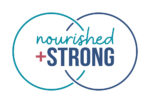One of the most helpful tools that we have at our disposal at Nourished & Strong is the metabolism test. Metabolism itself, often shrouded in mystery and misconceptions, is essentially the process by which your body converts food and drink into energy. While there will always be variability due to changes in fitness level, sleep patterns, etc., when we run the test, we are able to roughly calculate your body’s daily caloric needs. But one of the most common questions we hear from clients is “Why would I need the test if I’m not trying to focus on weight/weight loss?” Well, we’re glad you asked!
First, how does the test work?
Instead of using bogus online calculators that guesstimate your needs based on only four demographic points (Do you truly believe that every single person of the same gender, age, height, and weight needs the exact same calories per day?), the metabolism test gives you reliable, personalized data that you can actually trust.
How? The Korr ReeVue machine we have in office uses indirect calorimetry – the goal standard for assessing resting metabolic rate (RMR) and the FDA-approved method to deliver this info to clients. Indirect calorimetry works by calculating pulmonary gas exchanges – oxygen consumption vs. carbon dioxide production. In other words, it measures oxygen in with every inhale and CO2 out with every exhale. CO2 is a metabolic byproduct, and how quickly your body converts O2 to CO2 lets us know how fast your metabolism is working. While a lot goes into the calculations, all you have to do is breathe and let the ReeVue machine do the rest.
How do we use the info?
After you have done your part (read: breathed for 10 mins), the results are immediately available for your RD to interpret! The two main things we are looking at from the test are:
Your RMR results
-
- This is the number of calories you burn in a day ENTIRELY AT REST. We aren’t talking about a lazy day watching Netflix. We are talking about if you were completely unable to move!
The “speed” of your metabolism compared to predicted
-
-
- Based on your demographics, the test will also tell us if your metabolism is burning calories at a faster or slower rate than we would expect. This speed is due largely to genetics, age, gender, etc., but our lifestyle choices also have more of an impact than we realize. That’s where your RD comes in!
-
Why would I need the test if I’m not trying to focus on weight/weight loss?
At Nourished & Strong, we do our best to work within the intersection of: 1) external evidence-based practice and 2) your body’s own internal, intuitive wisdom. Unfortunately for many of us, the latter has been stripped away early in life, and we have to learn to reconnect with our body’s natural cues. This is where the metabolism test can come in handy, combining the hard science with your natural intuition.
Uses of the Metabolic Test that don’t Include Calorie Counting
- Reconnect to your innate hunger and fullness levels
- Chronic over or undereating, severe stress, overexercising, grief, etc. can all “throw off” our ability to feel hunger and/or fullness. With the data from the metabolism test, we can work to get your brain and body back on the same team again to meet those needs by assessing for disparities in what your body seems to be telling you vs. what it actually asking for.
- Visualize a “day on a plate”
- Using your personalized data, your RD can help to walk you through what your needs look like on actual plates, not in numbers. This way you can visualize what types of foods in what portions would best fit for you – all without the daunting job of calorie counting.
- Gain more knowledge of lifestyle behaviors that impact metabolism
- While we can’t change our genetic blueprint, we can still influence our metabolic rate.
- Spoiler alert: no one singular food is a “metabolism killer”, despite what that one random guy on YouTube said.
- Your long term habits (read: sleep, hydration, stress, micronutrient intake, etc.) are what really shape your metabolic rate from a lifestyle perspective. Your RD will walk through each piece of that puzzle with you to discuss potential changes that actually feel doable.
- While we can’t change our genetic blueprint, we can still influence our metabolic rate.
What are some of the fallacies around metabolism?
Diet culture wants us to operate on the idea that “less is more” – “the fewer calories, the better.” But keep in mind that your body can’t tell the difference between dieting and experiencing starvation. If your body is functioning on too few calories for too long, your metabolic rate will start to slow down as a protective mechanism. Counterintuitively, you might need to eat MORE to heal your metabolism, not less.
Beyond that, your body uses calories for so many things other than fat storage; your brain alone uses 20-30% of the calories you take in each day. If you cut your intake below your estimated needs – while you think you might just be trying to slim down – you could be negatively impacting cognition, mood regulation, sleep patterns, immunity, etc.
TLDR Version:
Sometimes clients feel like they are bowling through life and hopping from one gutter ball (i.e. super regimented, over restrictive diets) to another gutter ball (i.e. feeling out of control around food with a “no rules!” mentality). The metabolism test is one example of the type of “bumper” guidance provided at Nourished & Strong. It’s meant to keep you – gently – in the middle of the lane. At the end of the day, your body’s own personal cues should still be your “North Star” in the process of nourishing yourself. Our goal is to get your body and brain on the same team again, and the metabolism test can give us data to work with as a baseline starting point to do just that. Everyone’s metabolism is different. To find out more about your body’s own unique metabolic processes, test – don’t guess! Book a discovery call to learn more today.



